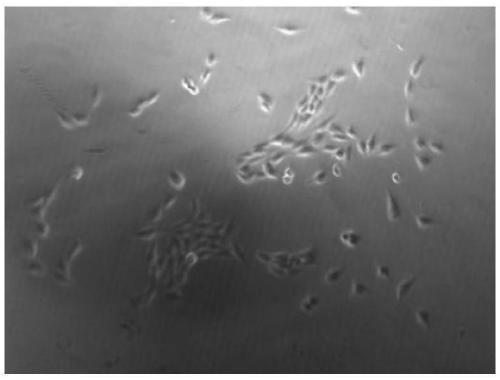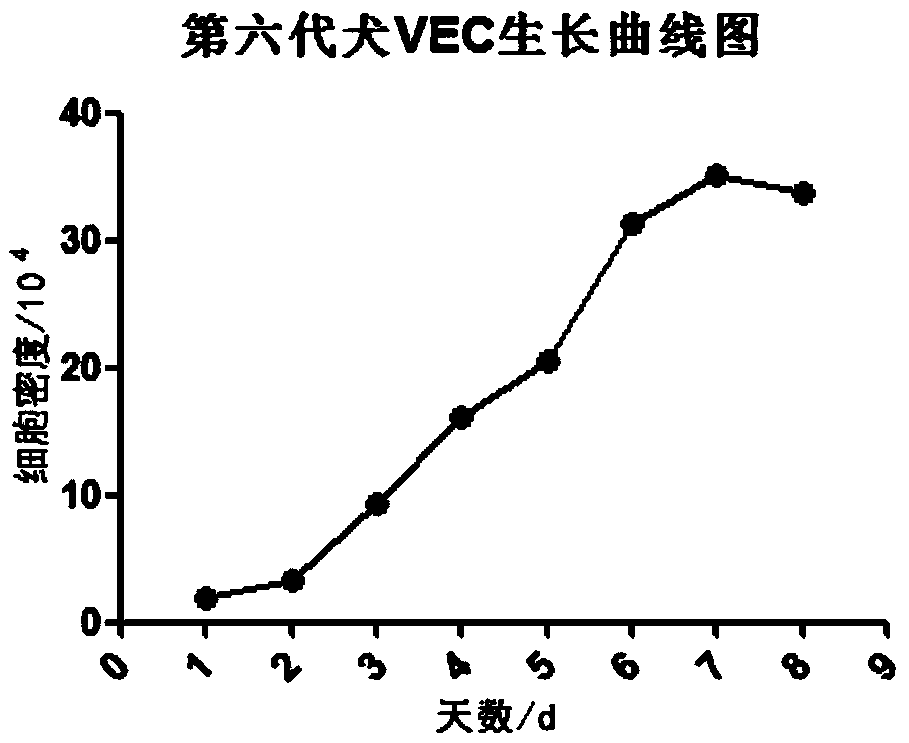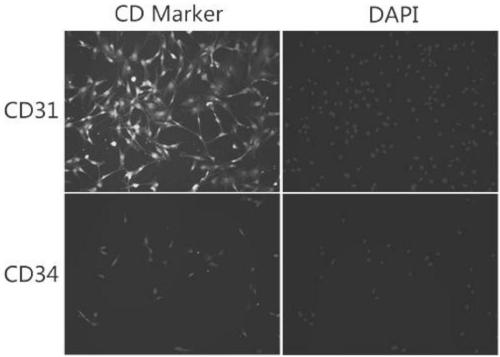Isolated culture method for primary canine vascular endothelial cells
A technology for vascular endothelial separation and culture, applied in vascular endothelial cells, cell dissociation methods, tissue culture, etc., can solve the problems of cumbersome steps, small number of cells, and restrictions on the development of vascular endothelial cell separation and purification applications, and achieve simple operation , short experimental time, avoiding the effect of ethical controversy
- Summary
- Abstract
- Description
- Claims
- Application Information
AI Technical Summary
Problems solved by technology
Method used
Image
Examples
Embodiment 1
[0043] This embodiment discloses a method for isolating and culturing primary canine vascular endothelial cells, comprising the following steps:
[0044] (1) Get the puppy that just died in a car accident, clean up the blood and dirt on the corpse, shave the chest and abdomen in the aseptic operating room after wiping and disinfecting the chest and abdomen with tincture of iodine, and then wipe the tincture of iodine with 75% alcohol. Open the chest cavity, cut the aorta about 4cm away with sterile scissors, squeeze out the remaining congestion in the blood vessel with tweezers, soak it in 75% alcohol for 10 seconds, take it out and place it in a clean workbench;
[0045] (2) Soak the blood vessel with PBS solution containing 5% double antibody solution (penicillin-streptomycin mixed solution), carefully peel off the hoof tissue attached to the surface of the blood vessel, and then use sterile pointed forceps to insert one end of the blood vessel inward Lumen, slowly move the ...
Embodiment 2
[0057] In this embodiment, the growth curve of canine vascular endothelial cells (VEC) is drawn, and the specific operations are as follows:
[0058](1) The primary canine vascular endothelial cells in Example 1 were subcultured to the sixth generation, and the well-grown vascular endothelial cells were taken and digested with 0.25% trypsin to make a cell suspension;
[0059] (2) Dilute the cells to 2×10 4 / mL inoculated into 24-well plate, 0.5mL per well, placed in 5% CO 2 , cultured in a 37°C incubator;
[0060] (3) Randomly extract cells from 3 wells at the same time every day, digest them with trypsin to make a suspension, count them under a microscope, and count three times in each well to get the average value;
[0061] (4) Continuous counting for eight days, according to the counting results, with the cell density as the ordinate (unit / mL) and the time as the abscissa, draw as follows figure 2 The growth curve graph shown. From figure 2 It can be seen that the pr...
Embodiment 3
[0063] In this example, an immunofluorescence identification experiment was performed on the sixth-generation canine vascular endothelial cells, and the specific steps were as follows:
[0064] (1) The primary canine vascular endothelial cells in Example 1 are subcultured to the sixth generation, and the well-grown vascular endothelial cells are taken, seeded on a gelatin-coated culture plate, and the cells are adhered to the wall for 12 hours, discarded The culture medium was washed twice with PBS solution containing 5% FBS (fetal bovine serum);
[0065] (2) Add 4% paraformaldehyde containing 0.1% Triton×100 to fix at room temperature for 5 minutes, remove the fixative, and wash 3 times with PBS solution containing 5% FBS;
[0066] (4) Add blocking solution (PBS containing 10% FBS), block at 37°C for 1 hour, remove the blocking solution, and wash 3 times with PBS solution containing 5% FBS;
[0067] (5) Add the primary antibodies of CD31 (purchased from Bioss, Cat. No. bs-09...
PUM
 Login to View More
Login to View More Abstract
Description
Claims
Application Information
 Login to View More
Login to View More - R&D
- Intellectual Property
- Life Sciences
- Materials
- Tech Scout
- Unparalleled Data Quality
- Higher Quality Content
- 60% Fewer Hallucinations
Browse by: Latest US Patents, China's latest patents, Technical Efficacy Thesaurus, Application Domain, Technology Topic, Popular Technical Reports.
© 2025 PatSnap. All rights reserved.Legal|Privacy policy|Modern Slavery Act Transparency Statement|Sitemap|About US| Contact US: help@patsnap.com



